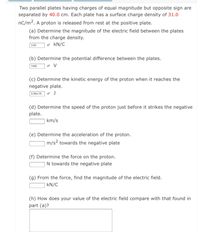Question
Help Part D, E, F, g,h

Transcribed Image Text:Two parallel plates having charges of equal magnitude but opposite sign are
separated by 40.0 cm. Each plate has a surface charge density of 31.0
nC/m2. A proton is released from rest at the positive plate.
(a) Determine the magnitude of the electric field between the plates
from the charge density.
3.50
v kN/C
(b) Determine the potential difference between the plates.
1400
(c) Determine the kinetic energy of the proton when it reaches the
negative plate.
2.24e-16 J
(d) Determine the speed of the proton just before it strikes the negative
plate.
km/s
(e) Determine the acceleration of the proton.
m/s? towards the negative plate
(f) Determine the force on the proton.
N towards the negative plate
(g) From the force, find the magnitude of the electric field.
kN/C
(h) How does your value of the electric field compare with that found in
part (a)?
Expert Solution
This question has been solved!
Explore an expertly crafted, step-by-step solution for a thorough understanding of key concepts.
This is a popular solution
Trending nowThis is a popular solution!
Step by stepSolved in 2 steps

Knowledge Booster
Similar questions
- How do you solve this problem?arrow_forwardElec X sou X Q Abc x Suck X SF Assi X ta The X A block Cchegg.coC chegg.co chegg.co The pers chegg.co + C use11fl.theexpertta.com/Common/TakeTutorialAssignment.aspx# theExpertTA.com Student bowenj@patriots.cf.edu My Account Log Out EXPERT ta Assignment Status Click here for detailed view Class Management | Help Work, Energy and power Begin Date: 2/29/2024 12:01:00 AM -- Due Date: 3/12/2024 11:59:00 PM End Date: 3/12/2024 11:59:00 PM (8%) Problem 9: A block of mass m is initially at rest at the top of an inclined plane which has a height of 4.67 m and makes an angle of 0=24.3° with respect to the horizontal. After being released, it is observed to be traveling at v=0.49 m/s a distance d after the end of the inclined plane, as shown. The coefficient of kinetic friction between the block and the plane is μp = 0.1, and the coefficient of friction on the horizontal surface is μr = 0.2. h m d m Problem Status * 50% Part (a) What is the speed of the block, in meters per second, just after it…arrow_forwardNeed help with part a, b, and carrow_forward
arrow_back_ios
SEE MORE QUESTIONS
arrow_forward_ios